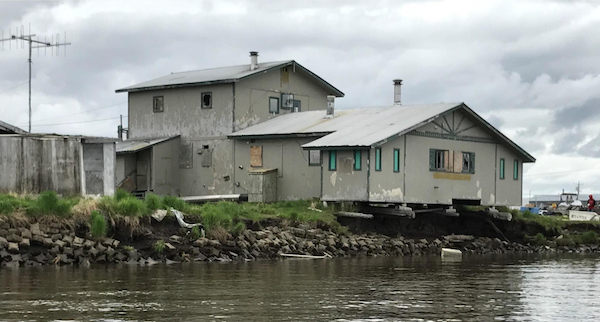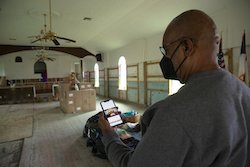SEJournal Online is the digital news magazine of the Society of Environmental Journalists. Learn more about SEJournal Online, including submission, subscription and advertising information.
 |
| As Alaska’s permafrost thaws, sinkholes have swallowed homes and erosion has eaten away at riverbanks. In Kotlik, Alaska, above, many houses and other buildings hang precipitously over the water as the ground beneath them washes away. Photo: Courtesy of the village of Kotlik. |
Feature: Collaborative Journalism Project Reveals Inequities in Escaping Climate Change Hazards
By Alex Lubben
As the climate crisis accelerates, and hurricanes, wildfires and floods hit with increasing frequency and intensity, people across the United States are starting to ask themselves an existential question: How much longer can we live here?
Many affected cities and towns are just starting to reckon with the fact that they will no longer be habitable on a heating planet, but the residents of some — in areas as varied as Alaska and Louisiana (more below) — already know they can’t stay where they are.
Often, though, they can’t afford to move on their own and aren’t able to access the limited federal grant money that could help them relocate.
Recently, three newsrooms — Columbia Journalism Investigations, a reporting unit at Columbia Journalism School, and the nonprofit journalism outfits The Center for Public Integrity and Type Investigations — joined forces to focus on these communities stranded in climate change’s path.
Living with risk by necessity
Over the course of a year-long investigation that became our Harm’s Way series, we tried to identify as many of these communities as possible. We submitted dozens of records requests, compiled and analyzed reams of data and conducted hundreds of hours of interviews.
We found that the communities most affected by the climate crisis are, in many cases, communities of color harmed by housing discrimination such as redlining. These communities have received less assistance through the federal programs that could help them relocate.
While people might think of climate relocation as a story of high-income residents giving up on seaside homes, what we found emphasizes how many people in the United States live with mounting flood and other climate risks not by choice but by necessity.
As Andrew Rumbach, a disaster researcher at the University of Texas A&M, told me: “Where’s low-income housing? It’s where land is cheap. Where’s land cheap? Where there’s hazards.”
No one will buy a house that’s been subsumed by rising sea levels or is often flooded, leaving homeowners with valueless assets. The government will likely be called on to help. And it is, to some extent, the government's responsibility for allowing so much development in floodplains in the first place.
The government is ill-equipped to help
move people out of harm’s way now that the
places where they live are increasingly unsafe.
Our investigation also shows that the government is ill-equipped to help move people out of harm’s way now that the places where they live are increasingly unsafe.
This has implications not just for the communities at risk, but also for people’s ability to become and stay part of the middle class. The idealized upwardly mobile path in the United States runs through homeownership, and many of the people we wrote about had worked hard to build wealth and invest it in their homes, only to have their property rendered uninhabitable by floods, fires or storms.
SIDEBAR: National Tools for Local ReportingTo better reach audiences on the front lines of this crisis, we worked collaboratively with local media outlets and developed a toolkit of reporting resources, including the dataset we compiled to find communities and analyze impact. You can access that toolkit here. The goal was to provide local reporters with information we’d gathered that might allow them to turn up climate relocation stories in their own coverage areas. We circulated a summary of our national-level findings, along with a brief explanation of major federal programs involved in climate relocation and adaptation that we’d identified. All of that information is still relevant, and we hope other journalists will find it useful for stories. Our local media partners discovered, for instance, that Hawaii is the only state to never receive federal flood buyouts (Honolulu Civil Beat), showed how California’s wildfires intersect with the state’s housing crisis (California Health Report) and investigated insufficient federal help after a flood (InvestigateWest), among other stories. |
Working around an information gap
This collaborative investigation started with a Freedom of Information Act request.
Academic experts told us that nobody had been able to quantify the number of people across the United States who want help to relocate but can’t get federal assistance to do so.
They also explained why it’s so difficult. There isn’t a single government agency tasked with helping residents move because their homes have suddenly started flooding every time there’s a high tide. Instead, communities have to cobble together funding through various federal and state agencies. The U.S. Environmental Protection Agency can help people move, as can the U.S. Department of Agriculture. The state of New Jersey has its own program; so does Harris County, Texas.
But experts told us that at the federal level, two agencies were responsible for the vast majority of (still limited) relocation efforts: the Federal Emergency Management Agency and the Department of Housing and Urban Development. We asked both for rejected applications to their programs that can provide relocation assistance.
While we waited for the FOIAs to be fulfilled, we compiled a data set to help us figure out where people were most at risk from hurricanes, floods and wildfires — the hazards that scientists told us were certain to become more frequent or intense as the climate heats — and might be least likely to afford a move on their own.
The data set ultimately included more than 100 columns, made up of data pulled from various sources, including federal disaster declarations, the Centers for Disease Control and Prevention’s Social Vulnerability Index and FEMA’s National Risk Index. (You can read more about the data analysis and access a simplified version of the dataset below.)
And while we analyzed the data, we filed records requests for rejected applications at the state level and talked to people across the country.
Plenty more stories to tell
In retrospect, it may have been naive to hope we could ground our investigation in documents obtained through FOIA from FEMA and HUD.
 |
| An Ironton, Louisiana, pastor ponders flooding damage done to his church by Hurricane Ida. Photo: Olga Loginova / Columbia Journalism Investigations |
We didn’t get responsive documents from these requests for 11 months. While we did receive a file detailing the flood buyouts that had taken place through FEMA’s programs, we did not receive the rejected applications that we’d asked for. After a year of corresponding with FOIA officers, we were finally told that we would need to go to each state to find those records.
Though we weren’t able to tell our readers how many people across the country wanted to move but weren’t able to, we didn’t have any trouble locating some of these communities. In fact, there were so many that we couldn’t feature all of them in our stories.
All along the Washington state coastline, tribal nations are planning for sea level rise and planning to move inland. In eastern Kentucky, communities face repeat flooding and recognize that they can’t stay where they are. And in Norfolk, Virginia, policymakers are putting forward some novel ideas for how to keep people from building near the city’s soon-to-be-submerged waterfront.
None of those communities made it into our series. That’s why we know there are plenty more stories to tell, likely some near you.
One of the places we did focus on was a rural village in Alaska where permafrost thaw and erosion threaten homes.
Another was Ironton, Louisiana, one of the first free Black communities in that state. Without government assistance to relocate after the ravages of Hurricane Ida, its residents might take buyouts from a public-private partnership that is trying to build a rail line through their town.
The series also touched down in Freeport, Illinois, where residents on the Black side of town are trapped in a floodway, legally barred from rebuilding their homes and distrustful of the local government offering to buy them out at values that might not allow them to relocate.
As one local official told us, “Resolving this situation should be a priority.” But across the country, it isn’t.
More reporting on this problem, and the potential fixes, could help turn the tide.
Alex Lubben is a climate and environment reporter in New York. He reported this series as a postgraduate reporting fellow at Columbia Journalism Investigations, the investigative reporting unit at Columbia Journalism School. His work has appeared in VICE News, NBC News, The Nation and other outlets.
* From the weekly news magazine SEJournal Online, Vol. 7, No. 44. Content from each new issue of SEJournal Online is available to the public via the SEJournal Online main page. Subscribe to the e-newsletter here. And see past issues of the SEJournal archived here.












 Advertisement
Advertisement 



